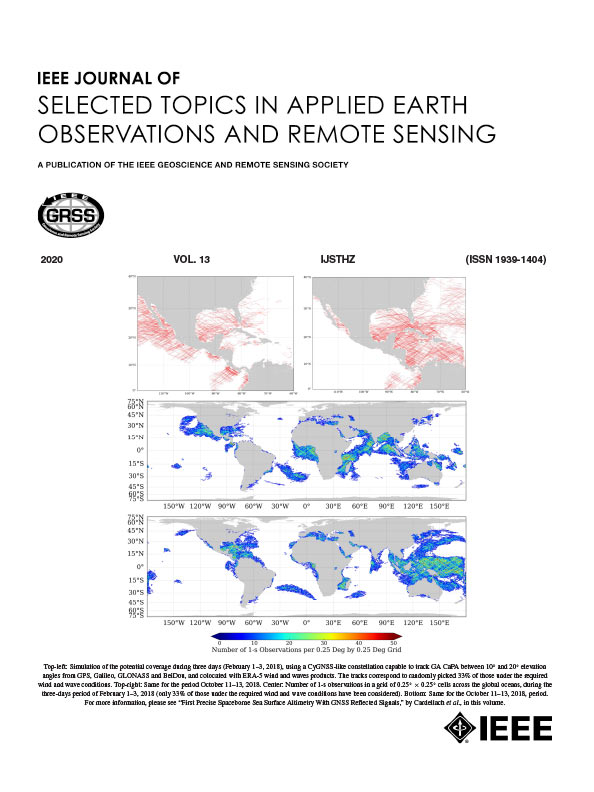Automated Collection Planning for Civilian and Commercial Satellite Imagery, and Definition and Exploitation of the Collection Asset Specification Data Structure
IF 4.7
2区 地球科学
Q1 ENGINEERING, ELECTRICAL & ELECTRONIC
IEEE Journal of Selected Topics in Applied Earth Observations and Remote Sensing
Pub Date : 2025-03-28
DOI:10.1109/JSTARS.2025.3555925
引用次数: 0
Abstract
There are more than 8000 traditional and small/microsatellites in low Earth orbit (LEO) and many of these are civilian and commercial satellites for remote sensing and space-based intelligence, surveillance and reconnaissance (ISR). Collection planning is the first step in the tasking, collection, processing, exploitation, and dissemination (TCPED) process and is required to choose the collection assets (satellites), instrument modes, and orbital passes that best match the collection task. Collection planning requires understanding and experience with: requirements; satellite and instrument phenomenologies, and capabilities; collection strategies; and data processing and exploitation methodologies. Given this, it is challenging for collection managers to make the best use of available satellites in the time available, and they would benefit from automation in the collection planning processes and systems. This article defines and describes collection planning terminology, notation, and processes. It defines new metrics for assessing the temporal coverage (completeness and density of collection opportunities along the time axis), and it describes six semiautomated tools and their underlying algorithms. These can be used by a collection manager to automate elements of the collection planning process, and they can be used for machine-to-machine communication using web services, thereby decreasing the total time required. This machine-to-machine communication permits the collection planning process to be completed in seconds instead of minutes or hours, time which can be critical for dynamic tasking such as tip and cue or last-minute retasking situations.民用和商用卫星图像的自动采集规划,以及采集资产规范数据结构的定义和利用
低地球轨道(LEO)上有 8000 多颗传统卫星和小型/微型卫星,其中许多是用于遥感和天基情报、监视和侦察(ISR)的民用和商用卫星。收集规划是任务分配、收集、处理、利用和传播(TCPED)过程的第一步,需要选择与收集任务最匹配的收集资产(卫星)、仪器模式和轨道经过。收集规划需要了解以下方面并积累相关经验:要求;卫星和仪器现象和能力;收集策略;数据处理和利用方法。有鉴于此,收集管理人员要在可用时间内充分利用可用卫星是一项挑战,他们将受益于收集规划流程和系统的自动化。本文定义并介绍了收集规划术语、符号和流程。文章定义了评估时间覆盖率(沿时间轴收集机会的完整性和密度)的新指标,并介绍了六种半自动化工具及其基本算法。藏品管理者可使用这些工具自动完成藏品规划流程的各个环节,也可使用网络服务进行机器对机器的通信,从而减少所需的总时间。这种机器对机器的通信可使藏书规划过程在几秒钟内完成,而不是几分钟或几小时。
本文章由计算机程序翻译,如有差异,请以英文原文为准。
求助全文
约1分钟内获得全文
求助全文
来源期刊
CiteScore
9.30
自引率
10.90%
发文量
563
审稿时长
4.7 months
期刊介绍:
The IEEE Journal of Selected Topics in Applied Earth Observations and Remote Sensing addresses the growing field of applications in Earth observations and remote sensing, and also provides a venue for the rapidly expanding special issues that are being sponsored by the IEEE Geosciences and Remote Sensing Society. The journal draws upon the experience of the highly successful “IEEE Transactions on Geoscience and Remote Sensing” and provide a complementary medium for the wide range of topics in applied earth observations. The ‘Applications’ areas encompasses the societal benefit areas of the Global Earth Observations Systems of Systems (GEOSS) program. Through deliberations over two years, ministers from 50 countries agreed to identify nine areas where Earth observation could positively impact the quality of life and health of their respective countries. Some of these are areas not traditionally addressed in the IEEE context. These include biodiversity, health and climate. Yet it is the skill sets of IEEE members, in areas such as observations, communications, computers, signal processing, standards and ocean engineering, that form the technical underpinnings of GEOSS. Thus, the Journal attracts a broad range of interests that serves both present members in new ways and expands the IEEE visibility into new areas.

 求助内容:
求助内容: 应助结果提醒方式:
应助结果提醒方式:


